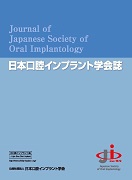Volume 34, Issue 4
Displaying 1-8 of 8 articles from this issue
- |<
- <
- 1
- >
- >|
Special Articles : Current Status and Future Outlook of Bone Augmentation Related Dental Implant Treatment : Long-term Cases in Particular
-
Article type: Special Articles : Current Status and Future Outlook of Bone Augmentation Related Dental Implant Treatment : Long-term Cases in Particular
2021Volume 34Issue 4 Pages 251
Published: December 31, 2021
Released on J-STAGE: February 05, 2022
Download PDF (699K) -
Article type: Special Articles : Current Status and Future Outlook of Bone Augmentation Related Dental Implant Treatment : Long-term Cases in Particular
2021Volume 34Issue 4 Pages 252-258
Published: December 31, 2021
Released on J-STAGE: February 05, 2022
Download PDF (1474K) -
Article type: Special Articles : Current Status and Future Outlook of Bone Augmentation Related Dental Implant Treatment : Long-term Cases in Particular
2021Volume 34Issue 4 Pages 259-263
Published: December 31, 2021
Released on J-STAGE: February 05, 2022
Download PDF (1344K)
Special Articles : The Current Status and Future Outlook of Sinus Lift
-
Article type: Special Articles : The Current Status and Future Outlook of Sinus Lift
2021Volume 34Issue 4 Pages 264
Published: December 31, 2021
Released on J-STAGE: February 05, 2022
Download PDF (698K) -
Article type: Special Articles : The Current Status and Future Outlook of Sinus Lift
2021Volume 34Issue 4 Pages 265-275
Published: December 31, 2021
Released on J-STAGE: February 05, 2022
Download PDF (3225K) -
Article type: Special Articles : The Current Status and Future Outlook of Sinus Lift
2021Volume 34Issue 4 Pages 276-285
Published: December 31, 2021
Released on J-STAGE: February 05, 2022
Download PDF (2194K)
Case Report
-
Article type: Case Report
2021Volume 34Issue 4 Pages 286-293
Published: December 31, 2021
Released on J-STAGE: February 05, 2022
Download PDF (2623K)
Survey, Statistics and Materials
-
Article type: Survey, Statistics and Materials
2021Volume 34Issue 4 Pages 294-297
Published: December 31, 2021
Released on J-STAGE: February 05, 2022
Download PDF (1071K)
- |<
- <
- 1
- >
- >|
